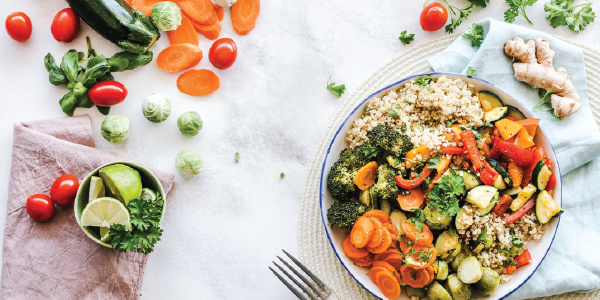We may earn money or products from the companies mentioned in this post.
A whole food, plant-based diet/lifestyle lets you meet your nutritional needs by only eating natural, minimally processed foods where none of the ingredients come from animals. It is based on two principles. Whole food describes natural foods that are not heavily processed. That means whole, unrefined, or minimally refined ingredients. Plant-based means food that comes from plants and doesn’t contain animal ingredients such as meat, milk, eggs, or honey.
There are many benefits to following a whole-food plant-based diet. They include:
- Weight Management- This way of eating helps you easily lose weight and keep it off.
- Prevention of Disease- Eating a whole food plant-based diet can help prevent chronic diseases.
- More Antioxidants Help Aging- Antioxidants can also help to slow some of the effects of aging in humans. When your diet puts less strain on the system, it is easier for the body to regenerate cells and keep your skin looking healthy.
3 Tips to Transitioning
One of the hardest parts of learning to eat a new way is figuring out how to do it. Here are some suggestions on how to transition to a whole-food plant-based diet.
Start Adding Things to Your Diet- This is going to be one of the most important steps you take. Often when we decide to change our diet, we think about the things we cannot eat instead of thinking of the things we are going to start adding. It may seem different at first when you begin to have meals that are not based around meat, but just remind yourself that you can still get all the nutrients you need through your new way of eating.
Start Out as A Vegetarian- This will help in the beginning not feeling as restricted and help you make a smooth transition. You can start by eliminating meats and then as you become more comfortable and confident you start to eliminate other foods and add in new ones. It is important that you are patient with yourself during this change.
Learn from People Who Are Already Incorporating A Whole-Food Plant-Based Lifestyle – This is always a great idea to find someone you can learn from as you begin your transition. They will be able to share things you never knew and give ideas on best practices to take along the way. Finding a community or a person will help you keep on track and give the support you will need when you are having a hard time or have questions.
Important Tips to Remember
When following this new type of diet/lifestyle change, it is important to remember that most of your foods will be fresh and whole, without any processing or preservatives. You will want to become familiar with what are the healthiest, unprocessed food and ingredients are where to find them when you go grocery shopping. Most of your shopping will be done in the produce section with the exception of finding products like nuts, olive oil, chia seeds.
One area where people go wrong with a whole foods diet is assuming regular fruit and veggies is all they can eat. While this does make up a good portion of your diet, you won’t get adequate calories and nutrition on those alone. Even while doing a whole food plant-based diet, you still need some starches to go with it. This is when you can get some vegan pasta noodles, make your own enchiladas, or use chickpeas to make hummus for a veggie wrap. Make sure everything you used is natural and not processed, and you’re good.
Following a whole food plant-based diet provides numerous health benefits. However, when you stop eating meat, one of the main nutrients you tend to lack is iron. You will need to look for alternative sources of iron, such as with the following foods.
3 Iron Rich Foods
Spinach
Spinach is one of the first foods that you should grab if you are looking for a high iron count. You can also use spinach in a versatile manner. Yes, you can use the spinach leaves in salads easily. You can even add them to juices and green smoothies. Spinach is an ideal choice for expectant mothers as well since it is so easy to add in meals and even freeze for meal planning.
Lentils
Lentils are an easy to prepare bean that can be used as a major base for entrees. You can make them in soups, add them as a side bean dish, and you can puree them as well. Lentils contain 3.3 mg of iron per half cup serving. This can be a huge benefit to dishes that need more iron or to people who need iron in their diet several times a day. You can have them at lunch, dinner, or even as a late-night soup based meal.
Almonds
If you need a source or iron on the go, then almonds are an ideal choice. You can grab them, mix them with dry fruits, or just eat them plain. They can easily be placed in everything from oatmeal to dinners. You can even soak almonds overnight and make them into an iron rich nut milk.
These sources are the most common sources of plant-based iron. You can generally find them at most grocery stores and at farmer’s markets around the world. If you find a source that you would like to utilize, but can’t find it fresh, consider frozen options or canned. Just make sure they are non-GMO.
As you begin to follow a whole food plant-based diet, remember these tips above and you will be on your way to a new healthy lifestyle.


